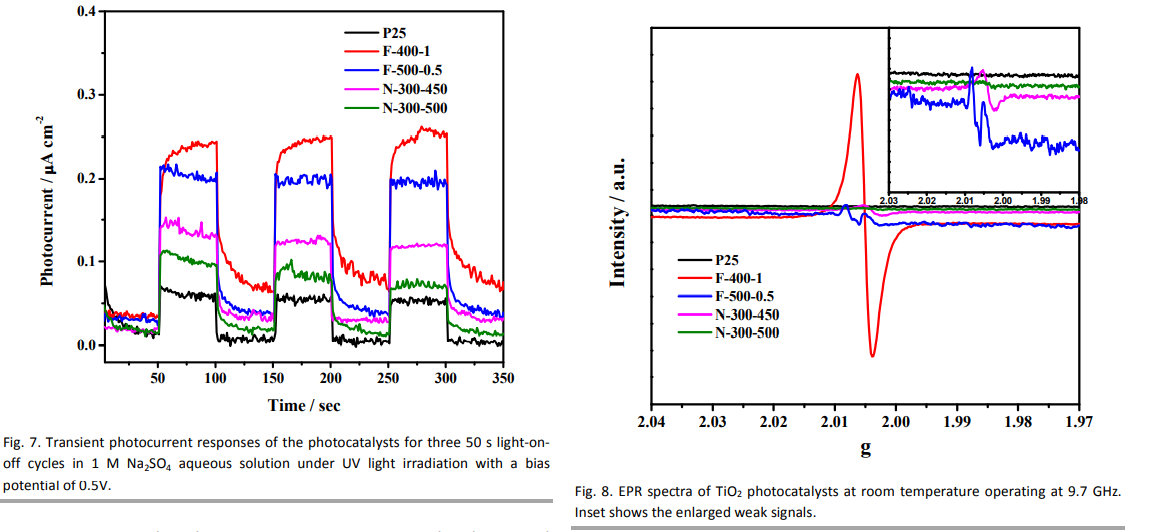Service hotline
+86 18518316054
 Current location : Home page > Resources > Papers > High photocatalytic activity of carbon doped TiO2 prepared by fast combustion of organic capping ligands†
Current location : Home page > Resources > Papers > High photocatalytic activity of carbon doped TiO2 prepared by fast combustion of organic capping ligands†
Yijun Yang,a Dawei Ni,b Ye Yao,b Yeteng Zhong,a Ying Ma,*b and Jiannian Yao*a
Carbon doping has been widely applied to modify TiO2 to improve photocatalytic activity and initiate visible light activity. Using oleylamine wrapped TiO2 nanomaterials as precursor, carbon doped TiO2 photocatalysts have been synthesized by control of heating ramp rates and temperatures in air. Optical absorption of all these photocatalysts are extended to visible light, and photogenerated electron-hole separation is enhanced by carbon doping. Especially, those prepared by fast combustion of oleylamine ligands exhibit excellent photocatalytic activity and visible light activity for hydrogen production. EPR analysis demonstrates that more oxygen vacancies present in carbon doped TiO2 with high activity. This indicates that oxygen vacancies may play key roles in photocatalytic water splitting. Fast heating process may have offered an oxygen-poor atmosphere in which oxygen vacancies are favoured.
Introduction
As a semiconductor photocatalyst, TiO2 has been extensively investigated for decades because of its outstanding stability, environmental friendliness and low cost.1-3 Many efforts have been made to improve its photocatalytic efficiency by extending its absorption to visible light or promoting photogenerated electron-hole separation on its surface. 4-6 Especially, improving absorption in visible range is very important for application considering that only about 4% solar light can be used to excite TiO2 . 7 Since Asahi et al. demonstrated band-gap narrowing and high photocatalytic activity under visible light of nitrogen doped TiO2 , 8 non-metal doping has been widely applied to modify band-gap structure of TiO2 to initiate visible light activity.9
In addition to nitrogen10, 11, carbon has also been well accepted as an efficient doping element to make TiO2 sensitive to visible light. Khan12 et al. firstly reported that TiO2–xCx (x ~ 0.15) absorbed light at wavelengths below 535 nm and performed water splitting at an applied potential of 0.3 V. Sakthivel and Kisch found good photocatalytic property of carbon doped TiO2 in degradation of 4-chlorophenol under diffuse indoor daylight.13 Various methods have been developed to synthesize carbon doped TiO2 and enhanced visible light activity of the doped photocatalyst has been verified by many groups subsequently.14-18 Among these methods, heating precursor containing carbon species is the most commonly used one for doping TiO2 with carbon19-21 . However, the existing states of carbon in these photocatalysts have triggered a lot of arguments. Carbon was proposed to substitute a lattice atom in some reports,12, 15, 22 while interstitial carbon atoms were believed to dominate in other works.16, 23 Recently, Kisch and co-workers have attributed the visible light activity of some “carbon-doped” TiO2 to the sensitization of TiO2 by aromatic carbon compound.24 Moreover, no visible activity or detrimental effect of C doping on photocatalytic activity of TiO2 under UV light was observed in some cases.25-27
Herein we report an easy way to fabricate carbon doped TiO2 with high photocatalytic activity for hydrogen production via fast combustion of organic capping reagents. During surface modification of TiO2 with carbon via heating oleylamine wrapped ultrathin TiO2 nanosheets,28 we noticed that elevating calcination temperature or heating rate in air would dope carbon into TiO2 lattice. By varying the temperature ramp-up rates, we prepared several carbon doped TiO2 photocatalysts. A high and stable hydrogen generation rate was observed on those prepared under a high heating rate, which benefits fast combustion of oleylamine ligands. In contrast, those prepared under a low heating rate exhibited a relative low activity under UV light and no activity under visible light. We think fast and slow combustion of oleylamine ligands may lead to different carbon doping states in the final products.
Experimental
Preparation of Pt-loaded photocatalysts Approximately 50mg of carbon-doped TiO2 materials was suspended with sonication in 8 mL of deionized water and 0.8 mL of H2PtCl6 (10 g L-1) aqueous solution. The pH value of the solution was adjusted to 12 by 10 M NaOH solution. Then the suspension was stirred at 50 °C for 5 h under ambient atmosphere, followed by adding 2 mL of methanol and irradiated using a 300 W Xenon lamp for 2 h (~ 600 mW cm-2 , CEL-HXF300, Beijing Aulight Co., Ltd.). The Pt-loaded photocatalysts were washed with water and ethanol and centrifuged, followed by drying in an electric oven at 60 °C for overnight. Photocatalytic hydrogen generation An online photocatalytic hydrogen generation system (AuLight, Beijing, CEL-SPH2N) was used to conduct the photocatalytic hydrogen evolution experiments at ambient temperature (25 °C). In a typical photocatalytic experiment, 50 mg of Pt-loaded photocatalyst was suspended in 100 mL of aqueous solution containing 40% of methanol in volume. Prior to irradiation, the suspension was degassed with vacuum pump for 10 min to completely remove the dissolved oxygen and to assure the reaction system in an inertial condition. A magnetic stirrer was applied at the bottom of the reactor to keep a good dispersion of the photocatalysts throughout the whole experiment. The hydrogen evolved was analysed by gas chromatograph (GC) using a thermal conductivity detector (TCD) with nitrogen as a carrier gas. Once the photocatalytic reaction of a testing cycle in 5 h was finished, the reactor was replenished with 2 mL of methanol and degassed in vacuum before starting the subsequent cycles. The above mentioned Xenon lamp (300 W, a total light intensity of 600 mW cm-2) was used as simulated light source. Visible light was acquired by equipping Xenon lamp with a 400 nm longpass filter (UVCUT400, AuLight, Beijing, λ>400 nm, ~ 550 mW cm-2). The apparent quantum efficiency (QE) was measured under the same photocatalytic reaction conditions with a 365 nm (~ 90 mW cm-2) and a 420 nm band-pass filter (~ 30 mW cm-2). The QE was calculated according to the following equation:

